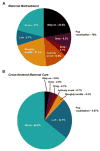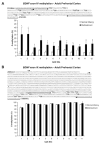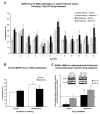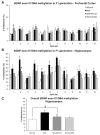Lasting epigenetic influence of early-life adversity on the BDNF gene - PubMed (original) (raw)
Lasting epigenetic influence of early-life adversity on the BDNF gene
Tania L Roth et al. Biol Psychiatry. 2009.
Abstract
Background: Childhood maltreatment and early trauma leave lasting imprints on neural mechanisms of cognition and emotion. With a rat model of infant maltreatment by a caregiver, we investigated whether early-life adversity leaves lasting epigenetic marks at the brain-derived neurotrophic factor (BDNF) gene in the central nervous system.
Methods: During the first postnatal week, we exposed infant rats to stressed caretakers that predominately displayed abusive behaviors. We then assessed DNA methylation patterns and gene expression throughout the life span as well as DNA methylation patterns in the next generation of infants.
Results: Early maltreatment produced persisting changes in methylation of BDNF DNA that caused altered BDNF gene expression in the adult prefrontal cortex. Furthermore, we observed altered BDNF DNA methylation in offspring of females that had previously experienced the maltreatment regimen.
Conclusions: These results highlight an epigenetic molecular mechanism potentially underlying lifelong and transgenerational perpetuation of changes in gene expression and behavior incited by early abuse and neglect.
Conflict of interest statement
The authors report no biomedical financial interests or potential conflicts of interest.
Figures
Figure 1. Infants experienced an adverse caregiving environment
(A) Qualitative assessment of the percent occurrence of pup-directed behaviors in the maltreatment condition indicates that pups experienced predominately abusive behaviors, which resulted in considerable audible pup vocalization. (B) In sharp contrast, pups experienced significant amounts of normal maternal care behaviors in the cross-fostered maternal care condition. Statistical analyses of the maternal behaviors (abusive versus normal care) are provided with Supplementary Figure 1.
Figure 2. Maltreatment during infancy decreases BDNF gene expression in the adult prefrontal cortex
Adult males and females exposed to maltreatment had less total BDNF mRNA (exon IX) in the prefrontal cortex than controls. Adults were derived from 5 mothers; n=7/group; *p-values significant versus both normal maternal care (t6=5.17, p=0.0021, one-sample t test) and cross-fostered controls (t12=2.19, p=0.0495, Student’s two-tailed t test). Maltreatment also increased levels of BDNF total mRNA in the hippocampus (t8=4.10, #p=0.0034, one-sample t test); however, maltreated-adults did not differ from cross-foster care controls; n=7–9/group. Error bars represent SEM.
Figure 3. Maltreatment during infancy elicits methylation of BDNF DNA in the prefrontal cortex
(A) Schematic of the BDNF gene, with positions of CpG islands (in grey) relative to the transcription start site (TSS, indicated by the bent arrow) of exons IV and IX. Methylated primer pair positions for each exon are indicated by the left and right arrows, and primer sequences can be found in Supplementary Table 1. (B) Methylation specific real-time PCR indicates that maltreatment results in methylation of BDNF DNA that persists into adulthood. For clarity of presentation, only the data generated in the abusive condition is illustrated. Experimental subjects (males and females) were derived from 13 mothers. n=4–9/group; *p-values significant versus normal maternal care (PN8 M p=0.0076, U p=0.0007; PN30 M p=0.0078, U p<0.0001; PN90 M(IV) p=0.0427, U(IV) p=0.0319, M(IX) p=0.0376, U(IX) p<0.0001; one-sample t tests) and cross-fostered controls (PN8 M p=0.0294, U p=0.0258; PN30 M p=0.0031, U p=0.0367; PN90 M p=0.0415, U p=0.0435; Student’s two-tailed t tests). Error bars represent SEM. PN=postnatal day; M=methylated; U=unmethylated.
Figure 4. Methylation analysis of individual CpG dinucleotides (BDNF exons IV and IX) from the prefrontal cortex of adults with a history of maltreatment or normal maternal care
(A) Location of 12 CpG sites relative to the transcription initiation site (bent arrow) of exon IV. Note that this region of exon IV contains a cAMP response element site (TCACGTCA) for transcription factor cAMP response element binding protein, which encompasses CpG site 1. Sequencing primer pair positions are indicated by the left and right arrows, and primer sequences can be found in Supplementary Table 1. Bisulfite DNA sequencing analysis indicates that maltreatment increases methylation of all CpG sites within the examined region of exon IV DNA in the adult prefrontal cortex (two-way ANOVA with Bonferroni’s post hoc tests; significant effect of infant condition F=46.62, p<0.0001). n=7–8/group; *p-values significant versus controls (p 0.05). (B) Location of 11 CpG sites within the common coding exon (IX) relative to two transcription initiation sites (bent arrows) in promoter IXA. *major splice site; sequencing primer pair positions are indicated by the left and right arrows, and primer sequences can be found in Supplementary Table 1. Bisulfite DNA sequencing analysis confirms that maltreatment during infancy results in site-specific methylation of exon IX DNA in the adult prefrontal cortex (n=9–11/group; two-way ANOVA with Bonferroni’s post hoc tests), with a significant increase at CpG site 11 (p=0.0161). For both panels - error bars represent SEM. Male and female adults were derived from 7 mothers.
Figure 5. Exposure to an adverse caregiving environment had no effect on Reelin gene expression or methylation of Reelin DNA
(A) Maltreatment or cross-fostered care during infancy had no detectable effect on Reelin mRNA levels in the adult prefrontal cortex (n=8–10/group). Male and female adults were derived from 5 mothers. (B) Schematic of the large CpG island (in grey) relative to the transcription start site (TSS) of the Reelin gene (note that the entire CpG island is not represented, but only the portion relevant to the primer target region). Methylated primer pair positions are indicated by the left and right arrows, and primer sequences can be found in Supplementary Table 1. (C) Exposure to the maltreatment condition had no observable effect on methylation of Reelin DNA within the prefrontal cortex. We also observed no changes in methylation of a CpG island located within an intragenic region of the Reelin gene (at location 2841591–2841823; data not shown). Male and female subjects were derived from 13 mothers; n=4–8/group. For panels A and C, error bars represent SEM. PN=postnatal day.
Figure 6. Infusions of a DNA methylation inhibitor in the adult rescues maltreatment-induced deficits in BDNF gene expression in the prefrontal cortex
(A) The effects of zebularine treatment on methylation of BDNF exon IV DNA (n=3–5/group; male and female adults were derived from 3 mothers). Maltreated animals infused with vehicle demonstrated significantly higher levels of methylation than controls, while zebularine treatment lowered levels of methylation in maltreated-animals (three-way ANOVA with Bonferroni’s post hoc tests; significant effects of infant condition F=18.44, p<0.0001, CpG region F=7.69, p<0.0001, and infant condition × drug interaction F=6.73, p=0.0103). *p-values significant versus adults with a normal infancy infused with vehicle (p 0.05). (B) Average percentage of methylation across the examined CpG sites of exon IV in subjects from panel A (two-way ANOVA with Bonferroni’s post hoc tests; significant effect of infant condition F=13.54, p=0.0003 and infant × drug interaction F=4.94, p=0.0273). *p-value significant versus adults with normal infancy (p<0.0001); #p-value significant versus maltreated-animals infused with vehicle (p=0.05). Maltreated-animals that received zebularine were not significantly different from normal controls. (C) The effects of zebularine treatment on mRNA (n=4–6/group). Animals with a history of maltreatment infused with vehicle demonstrated a significant decrease in both exon IV BDNF mRNA and total BDNF mRNA (exon IX). *p-values significant versus adults with a normal infancy infused with vehicle (exon IV t5=10.94, p=0.0001; exon IX t5=2.82, p=0.0373, one-sample t tests) or zebularine (exon IV t8=2.19, p=0.06; exon IX t9=2.29, p=0.0474, Student’s two-tailed t test). Zebularine treatment rescued the maltreatment-induced reduction in BDNF mRNA expression (exon IV t8=3.05, #p=0.0159; exon IX t10=2.91, #p=0.0156, Student’s two-tailed t test), and animals did not differ from normal maternal care controls. Agarose gel images represent total BDNF gene expression (IX). For all panels, error bars represent SEM. NMC=normal maternal care; MAL=maltreatment.
Figure 7. Females with a history of maltreatment display aberrant maternal behavior toward their own offspring
(A) Qualitative assessment of the percent occurrence of pup-directed behaviors in females with a history of infant maltreatment indicates that females display considerable abusive behaviors toward their first offspring. (B) In sharp contrast, females with a history of normal maternal care display predominately normal maternal care behaviors toward their first offspring. n=4–5/group, derived from 3 mothers. Statistical analysis of the maternal behaviors (abusive versus normal care) is provided with Supplementary Figure 3.
Figure 8. Direct bisulfite sequencing confirms that DNA methylation patterns incited by maltreatment are perpetuated to the next generation, and that cross-fostering fails to completely rescue DNA methylation patterns
(A) Sequencing reveals site-specific effects of mother history on methylation of exon IV DNA in offspring’s prefrontal cortex (two-way ANOVA with Fisher’s post hoc tests; significant effect of CpG site F=4.02, p<0.0001 and marginal effect of CpG site × mother history interaction F=1.45, p=0.06). At CpG site 12, offspring born to females with a history of maltreatment (Mal) have significant methylation in comparison to offspring from females with a history of normal infancy (*p=0.05). Cross-fostering mal-offspring to a female with a history of normal infancy (Mal-Normal) evokes an increase in methylation at CpG site 1 (#p-value significant versus mal and normal, p<0.01), while it reverses methylation at site 12 (#p-value significant versus mal, p=0.023). Cross-fostering normal offspring to a female with a history of maltreatment (Normal-Mal) is sufficient to increase methylation at site 12 (*p-value significant versus normal, p=0.05) (B) Sequencing detected significant methylation of exon IV DNA in the hippocampus of mal offspring (two-way ANOVA with Fisher’s post hoc tests; significant effect of CpG site F=5.21, p<0.0001 and mother history F=10.29, p<0.0001). *p-values significant versus normal, p<0.05. Cross-fostering (Mal-Normal) significantly reversed methylation at site 2 (#p-value significant versus mal offspring, p=0.04). (C) Average percentage of methylation across the examined CpG sites of exon IV in subjects from panel B (one-way ANOVA with Fisher’s post hoc tests; F=8.59, p<0.0001). *p-value significant versus normal, p<0.0001. Though cross-fostering (Mal-Normal) was able to reduce methylation (#p-value significant versus mal, p=0.004), methylation in these animals was still significantly higher than normal controls (p=0.034). Cross-fostering normal offspring to maltreated-females did not induce significant methylation. In all panels, n=3–8/group, derived from 7 mothers; error bars represent SEM.
Figure 9. Females with a history of maltreatment display more anxiety-related behaviors during the prepartum period
Assessment of behaviors 3 days prior to giving birth indicates that females with a history of maltreatment had increased (A) self-grooming and (B) rearing behaviors than females with a normal infancy. n=4–5/group; self-grooming t7=2.44, p=0.0448; rearing t6=3.12, p=0.0205; Student’s two-tailed t tests. (C) Digging behaviors were not affected by prior experience.
Similar articles
- Preventing epigenetic traces of caregiver maltreatment: A role for HDAC inhibition.
Doherty TS, Chajes JR, Reich L, Duffy HBD, Roth TL. Doherty TS, et al. Int J Dev Neurosci. 2019 Nov;78:178-184. doi: 10.1016/j.ijdevneu.2019.05.002. Epub 2019 May 7. Int J Dev Neurosci. 2019. PMID: 31075305 Free PMC article. - Global and gene-specific DNA methylation alterations in the adolescent amygdala and hippocampus in an animal model of caregiver maltreatment.
Doherty TS, Forster A, Roth TL. Doherty TS, et al. Behav Brain Res. 2016 Feb 1;298(Pt A):55-61. doi: 10.1016/j.bbr.2015.05.028. Epub 2015 May 28. Behav Brain Res. 2016. PMID: 26027495 Free PMC article. - Differential methylation of genes in the medial prefrontal cortex of developing and adult rats following exposure to maltreatment or nurturing care during infancy.
Blaze J, Scheuing L, Roth TL. Blaze J, et al. Dev Neurosci. 2013;35(4):306-16. doi: 10.1159/000350716. Epub 2013 Jun 8. Dev Neurosci. 2013. PMID: 23751776 Free PMC article. - The Relationships Between Stress, Mental Disorders, and Epigenetic Regulation of BDNF.
Miao Z, Wang Y, Sun Z. Miao Z, et al. Int J Mol Sci. 2020 Feb 18;21(4):1375. doi: 10.3390/ijms21041375. Int J Mol Sci. 2020. PMID: 32085670 Free PMC article. Review. - Transcriptional and epigenetic changes of brain derived neurotrophic factor following prenatal stress: A systematic review of animal studies.
Badihian N, Daniali SS, Kelishadi R. Badihian N, et al. Neurosci Biobehav Rev. 2020 Oct;117:211-231. doi: 10.1016/j.neubiorev.2019.12.018. Epub 2019 Dec 12. Neurosci Biobehav Rev. 2020. PMID: 31838194
Cited by
- Toward Understanding How Early-Life Stress Reprograms Cognitive and Emotional Brain Networks.
Chen Y, Baram TZ. Chen Y, et al. Neuropsychopharmacology. 2016 Jan;41(1):197-206. doi: 10.1038/npp.2015.181. Epub 2015 Jun 24. Neuropsychopharmacology. 2016. PMID: 26105143 Free PMC article. Review. - Complex epigenetic regulation of engrailed-2 (EN-2) homeobox gene in the autism cerebellum.
James SJ, Shpyleva S, Melnyk S, Pavliv O, Pogribny IP. James SJ, et al. Transl Psychiatry. 2013 Feb 19;3(2):e232. doi: 10.1038/tp.2013.8. Transl Psychiatry. 2013. PMID: 23423141 Free PMC article. - How The Genome Got a Life Span.
Lappé M, Landecker H. Lappé M, et al. New Genet Soc. 2015 Apr 3;34(2):152-176. doi: 10.1080/14636778.2015.1034851. New Genet Soc. 2015. PMID: 26213491 Free PMC article. - Epigenetic regulation of memory formation and maintenance.
Zovkic IB, Guzman-Karlsson MC, Sweatt JD. Zovkic IB, et al. Learn Mem. 2013 Jan 15;20(2):61-74. doi: 10.1101/lm.026575.112. Learn Mem. 2013. PMID: 23322554 Free PMC article. Review. - The impact of early-life environment on absence epilepsy and neuropsychiatric comorbidities.
Sarkisova K, van Luijtelaar G. Sarkisova K, et al. IBRO Neurosci Rep. 2022 Nov 9;13:436-468. doi: 10.1016/j.ibneur.2022.10.012. eCollection 2022 Dec. IBRO Neurosci Rep. 2022. PMID: 36386598 Free PMC article. Review.
References
- Cicchetti D, Toth SL. Child maltreatment. Ann Rev Clin Psychol. 2005;1:409–438. - PubMed
- De Bellis MD. The psychobiology of neglect. Child Maltreatment. 2005;10:150–172. - PubMed
- Lee V, Hoaken PN. Cognition, emotion, and neurobiological development: mediating the relation between maltreatment and aggression. Child Maltreatment. 2007;12:281–298. - PubMed
- Kaffman A, Meaney MJ. Neurodevelopmental sequelae of postnatal maternal care in rodents: clinical and research implications of molecular insights. J Child Psychol Psychiatry. 2007;48:224–244. - PubMed
- Fumagalli F, Molteni R, Racagni G, Riva MA. Stress during development: impact on neuroplasticity and relevance to psychopathology. Prog Neurobiol. 2007;81:197–217. - PubMed
Publication types
MeSH terms
Substances
Grants and funding
- F32 NS048811/NS/NINDS NIH HHS/United States
- R01 AG031722/AG/NIA NIH HHS/United States
- R01 MH057014/MH/NIMH NIH HHS/United States
- NS048811/NS/NINDS NIH HHS/United States
- MH57014/MH/NIMH NIH HHS/United States
LinkOut - more resources
Full Text Sources
Other Literature Sources
Medical








